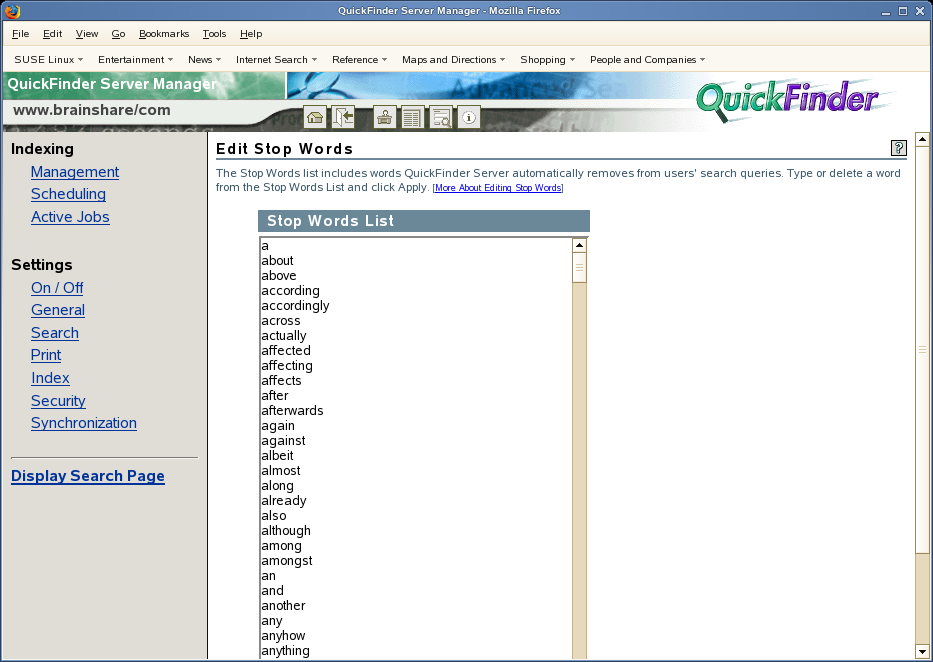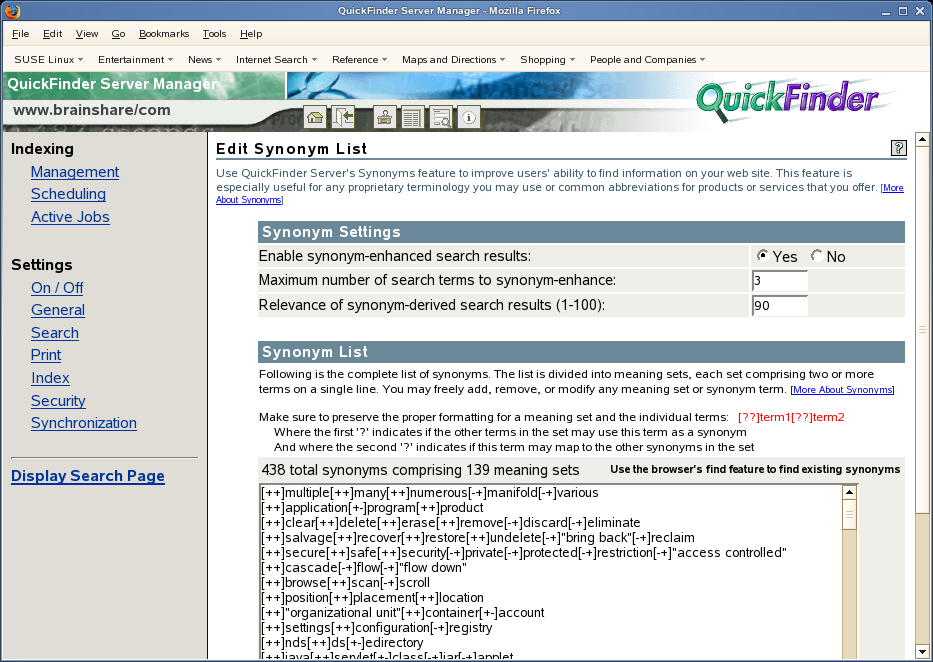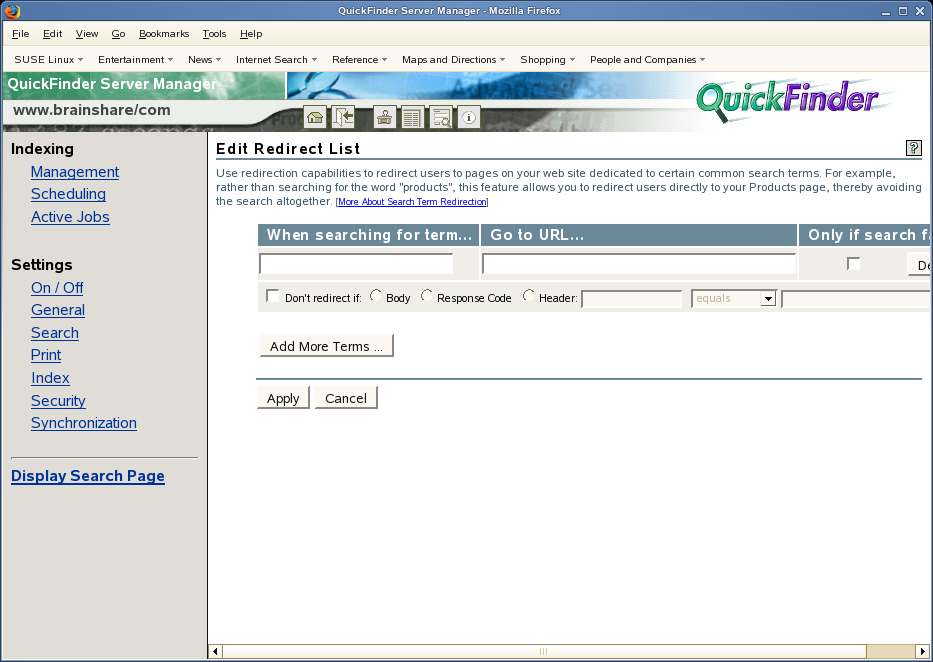10.5 Improving Search Results
There are many things you can do to improve the speed, accuracy, and relevance of search results for end users.
10.5.1 Improving the Relevance of Search Results
QuickFinder uses a sophisticated relevance-ranking algorithm. During a search, QuickFinder considers
-
The number of times words appear in a document
-
The proximity of words in a multiple word search (the closer the words are to each other, the more relevant the document is)
-
The order of words in a multiple-word search (the exact order of words is more relevant)
-
The location of words in a document (specifically words that appear in a meta tag, title, body, header, footer, etc.)
-
The formatting of words in a document (such as bold, font type and size, etc.)
-
Query weighting in a multiple query scenario
-
The number of times words occur within an entire index (for example, the word “the” has low relevance)
-
The date of the document
-
The depth of the document
-
The index, path, and URL weights
-
Off-site links
-
Synonyms (synonym-derived hits are slightly less relevant by default)
To illustrate how these criteria work, consider the following examples:
-
Words in bold are more relevant than regular words.
-
Words contained in the <Title> tag are more relevant than words contained within the <body> tag.
-
Words contained in the Keywords and Description meta tags are more relevant than content words.
-
Words contained within the <A HREF=> tag used for creating links are less relevant than words outside of this tag.
-
A document containing a specified search term multiple times is more relevant than a document that contains the search term only once.
-
A word within a 36-point body text is more relevant than within 4-point footer text.
-
Documents returned from a query that is weighted at 100% are more relevant than those returned from a 50% weighted query. This is normally used in multi-query searches where each query has a specified weight. For example:
query0=netware&weight0=100&query1=groupwise&weight1=100
In addition to QuickFinder's inherent capabilities, you can further enhance the speed and accuracy of search results by enabling and configuring additional search features.
10.5.2 Using Stop Words Processing to Improve Search Speed
Sometimes users include irrelevant words in their search strings, such as the conjunctions and, to, and of. These are referred to as stop words. The Stop Words feature of QuickFinder removes all occurrences of stop words from the search string before performing a search, except in the following situations.
-
Stop words processing has been turned off.
-
You prepend the word with a plus (+) sign (for example, +the).
-
They are the only words in the query.
-
They occur within a phrase.
NOTE:The Boolean operators AND, OR, and NOT are treated as regular words if they are lowercase or in quotes and as Boolean operators if they appear in uppercase. For example:
jack and jill (searches for three words) “jack AND jill” (also searches for three words) jack AND jill (searches for two words)
A set of common stop words is included in QuickFinder, but you can easily add your own, or remove any of the existing stop words. See Editing the Stop-Words List for more information.
Before a virtual search server can use stop words processing, it must first be enabled on the QuickFinder server on the Global Settings page of QuickFinder Server Manager.
Enabling Stop Words Processing on a QuickFinder Server
-
On the Global Settings page of QuickFinder Server Manager, click under .
-
Under , click next to .
-
(Optional) Click to modify the default list of stop words, modify the list, then click .
-
Click .
Enabling Stop Words Processing on a Virtual Search Server
-
On the QuickFinder Server Manager Global Settings page, click in the row of the virtual search server that you want to enable stop words processing on.
-
Under , click .
-
Click next to .
-
(Optional) Click to modify the default list of stop words, modify the list, then click .

-
Click .
10.5.3 Using Best Bets to Help Users Find the Right Information
Best bets is a secondary results list that appears at the top of the search results page. It is generated from a special-purpose index, which is an index created for the express purpose of generating a best bets results list.
A best bets list can help users find what they are looking for more quickly by bringing the most popular or most important things to the top of the results page.
A special-purpose index typically contains information about the most popular, most recent, or most important documents.
Enabling Best Bets on a QuickFinder Server
-
On the Global Settings page of QuickFinder Server Manager, click under .
-
Click next to .
-
(Optional) If you want the best bets results to show automatically on the search results page, click next to .
-
(Optional) In the field, type the maximum number of best bets results to be returned on each search results page.
-
Click .
Enabling Best Bets on a Virtual Search Server
-
On the Global Settings page of QuickFinder Server Manager, click in the row of the virtual search server that you want to modify.
-
Under , click .
-
Click next to .
-
Click next to the field and select the indexes for use with best bets.
-
If you want the best bets results to show automatically on the search results page, click next to .
-
In the field, specify the maximum number of best bets results to be returned on each search results page.
-
(Optional) In the , type the number of low relevance documents you want removed from the best bets display list.
-
Click .
10.5.4 Using Synonyms to Broaden Search Results
When enabled, a synonym-enhanced search returns documents in the search results that contain synonyms of the user's original search terms. This can lead users to documents they might not otherwise find because they don't know the exact terminology.
If search results contain the original term, the relevance does not change. If results contain the original term and a synonym, relevance is boosted. If results contain only synonyms, relevance is adjusted by the value entered for the setting, which is usually slightly lower than the normal relevance.
Common synonyms are included in the QuickFinder Synonym List, but you can add new ones and delete existing ones.
When enabling synonym enhanced searches, keep the following things in mind:
-
A synonym-derived search result can be slightly less relevant than the original term.
-
A document containing both the original search term and one of its synonyms is more relevant than a document with only the original term.
-
Administrators control the Synonym List.
-
Synonyms enhancement is not performed within the FileFilter section of a search.
This section contains the following information:
Enabling Synonym-Enhanced Searches on a Virtual Search Server
-
On the Global Settings page of QuickFinder Server Manager, select a virtual search server from the Virtual Search Server List, then click .
-
Click under .
-
Click next to .
-
Click to save any changes you have made.
Clicking causes any unsaved changes to be lost.
-
(Optional) To reduce the relevance factor, click to the right of , specify a number in the field, then click .

The purpose of this feature is to keep long queries from timing out. Because a single search term could potentially have many synonyms, this feature lets you reduce the relevance factor, which reduces the total number of hits.
A value below 100 generates a second query containing the synonyms where the query weight is slightly lower than the original query weight. A value of 100 simply adds the synonyms to the user’s original query and gives all words equal weight.
The most effective relevance numbers are in the 90s. Searches are fastest when you set the relevance to 100. However, you l ose the benefit of synonym-derived search results when you set this number too high.
-
Click .
Editing the Synonyms List
-
On the Global Settings page of the QuickFinder Server Manager, select a virtual search server from the Virtual Search Server List, then click .
-
Click under to open the General Settings page.
-
Set to .
-
Click to save any changes you have made.
If you click a different option before you save, changes you make on this page are lost.
-
Click to the right of the.

-
Add or delete words as necessary to customize the synonym list.
The Synonym List contains a list of default synonyms included with QuickFinder. The synonyms are grouped by sets. A set is one row of synonyms in the list and contains words that are common synonyms of other word in the same set.
Each word in a set is preceded by a pair of brackets containing a combination of two plus (+) or minus (-) signs, which identify how the word they precede is to be interpreted.
Following table summerize your decision to use signs in a set:
For example:
[++]jobs[++}tasks[+-]threads signifies the following:
-
The word tasks can use jobs and threads as synonyms
-
The word jobs can use tasks and threads as synonyms.
-
When a user searches for threads, only the word threads is considered for search and the rest of the words in the set are ignored.
-
The word threads cannot use jobs and tasks as its synonym.
[++]certification[++]license[-+]permission signifies the following:
-
The words certification and license cannot use the word permission as a synonym.
-
The word permission can use both the words in the set as synonyms.
-
When a user searches for the words certification or license, the word permission is not considered for search.
-
-
When you have finished making changes by adding or deleting words and assigning the proper plus (+) or minus (-) symbols, click .
10.5.5 Redirecting Searches
The redirection feature lets you specify key words that redirect the user's Web browser to a specific URL.
To enable search term redirection on a QuickFinder server:
-
On the Global Settings page of QuickFinder Server Manager, click under .
-
Under , click next to .
-
(Optional) Click to create (or modify) the list of redirection terms and their associated URLs.
For more information, see Creating or Editing the Redirection URLs List.
-
Click .
10.5.6 Creating or Editing the Redirection URLs List
-
On the Global Settings page of QuickFinder Server Manager, click under .
-
Click to save any changes you have made.
Clicking causes any unsaved changes to be lost.
-
Click to create (or modify) the list of redirection terms and their associated URLs.

-
In the field, specify a search term.
-
In the field, specify the associated URL.
-
(Optional) Select the option if you want the search query to be redirected if a search fails to return any results.
-
(Optional) If you want additional control over when a search term is redirected to an alternate URL, check the check box and specify one or more of the following conditions:
-
Select if you want redirection disabled when a specific word or phrase is found in the body of a document returned during a search. From the drop-down list, select a condition (equals, begins with, contains, or ends with) and specify a word or phrase in the text field at the right.
-
Select if you want redirection disabled when a specific response code is returned. For example, if a user enters a search term that you have identified for redirection and a 404 Not Found error is returned for any reason, QuickFinder won't redirect the request to the alternate URL. Specify the response code to be used in the text field to the right of the drop-down list.
-
Select if you want redirection disabled when a specific word or phrase is found in the header section of a document returned during a search. From the drop-down list, select a condition (equals, begins with, contains, or ends with) and specify a word or phrase in the text field at the right.
-
-
Click , then click .